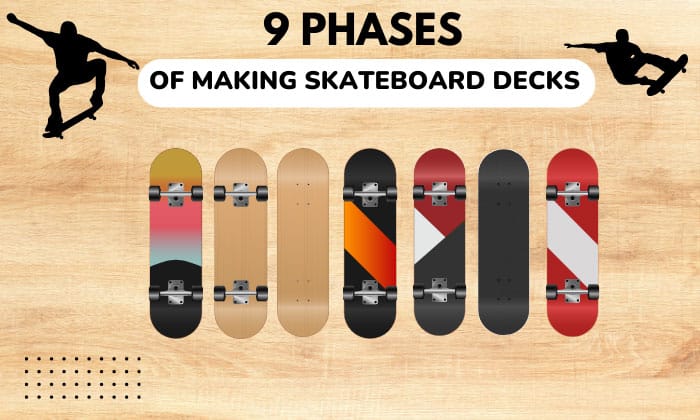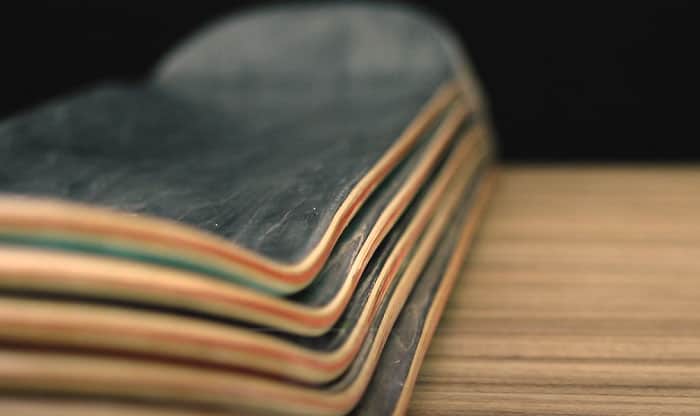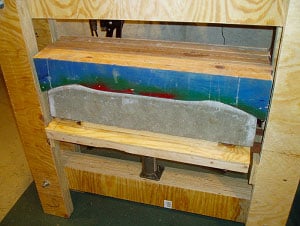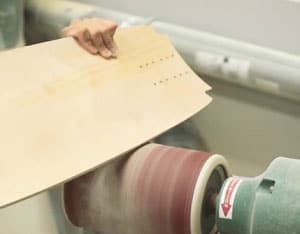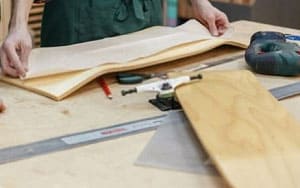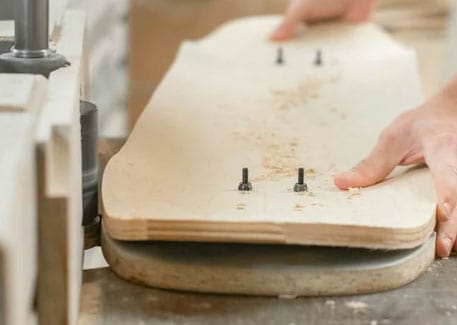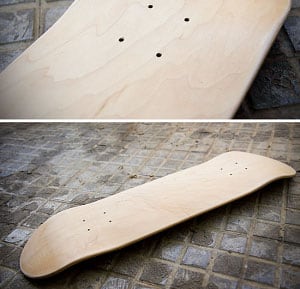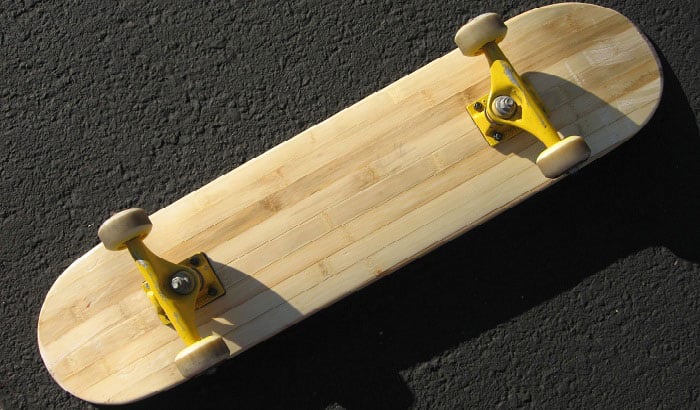In a sport like skateboarding, curiosity brings us to places. It doesn’t signify a lack of knowledge on our part but rather a drive to go beyond tricks and skills.
Are there other things to learn besides jumps and flips? Absolutely! One of them is skateboard parts and their composition. And there’s no better way to start than by learning how skateboard decks are made right here.
Table of Contents
The Process of Making Skateboard Decks
Learn how skateboard materials are used to form decks below. Maybe this knowledge will help you make your own.
Phase 1: Wood sourcing
Most quality skateboards are not made from 1 hard maple tree but three to five. The wood pieces come from cold climate areas, usually North America, and are famous for being solid and poppy.
Phase 2: Wood treatment
Before cutting the maple, wood suppliers or similar groups store the harvested log in a facility. The wood sits under a specific temperature until it’s ready for cutting. Then, suppliers send the wood to another facility or deck manufacturer for further processing.
Phase 3: Wood cutting
After the initial treatment, wood processors or skateboard manufacturers perform a bucking process where they cut the maple wood into halves or quarters and heat the pieces with water or steam at 93°C.
Such a process will give skateboarding manufacturing houses an easy time peeling the veneers.
After bucking, manufacturers use a lathe machine to slice the logs. How thin do they make the pieces? 1/16″.
Phase 4: Drying
The veneers are now in their final thickness for gluing, but remember that we have received a wetted log. So, the manufacturers will reduce the wood’s moisture content to 8% to prepare it for epoxy.
Phase 5: Veneer classification
It’s not wise to stack maple layers without checking which ones fit the surface and core.
Hence, manufacturers classify the veneers into the following.
- Face – Top and bottom of the skateboard deck
- Core – Has long grains but blemished compared to the former
- Cross-grain – Sideward-grained veneers that add overall deck strength
Phase 6: Coloring
Some manufacturers make skateboard decks more distinct by replacing the wood’s natural color with a new accent. Is wood staining the way to go? No.
Skateboard deck veneers pass through a pressure chamber that infuses various colors into their fibers. Dying won’t yield results as high and the wood could wear off after a few scrapes.
Phase 7: Gluing the veneers
Now that the layers are ready, skateboard deck manufacturing houses will glue them together. Here’s an example sequence of how brands assemble the deck’s veneers.
- Face
- Core
- Cross-grain
- Core
- Cross-grain
- Core
- Face
Note that manufacturers do not use casual wood glue in supermarkets. Most of them use Polyvinyl Assembly Adhesive or PVA.
Phase 8: Shaping the deck
How do manufacturing brands shape a skateboard deck?
Before they create a popsicle or fish shape based on various types of skate decks, companies slide the wood into a mold.
Skateboard molds give the skateboard deck the appropriate concavity, depth, and angles of the nose and tail. They need to be under the right amount of pressure (about 40 tons) to achieve the desired shapes.
Once the deck has undergone pressing, manufacturers will let it dry and cut through the glued veneers to achieve the planned skateboard shape.
Phase 9: Finishing
We finally have a freshly cut skateboard deck out of wood. From there, manufacturers will drill eight holes on the board to mount the skateboard trucks. And for a neat and smooth finish, workers will sand the deck.
How do skateboards gain more identity? Through graphics. Brands like Santa Cruz and Braille skateboards made their products recognizable by printing the company logo on the deck. Usually, this is done through a heat transfer process.
Such a method will incorporate the plastic graphic on the board, making it long-lasting and neat-looking.
Frequently Asked Questions
What wood are skateboards made of?
We don’t get free skateboard decks often due to the intricacy of their production. The competition among skateboard brands doesn’t stop. It only gets tighter based on how they make their boards durable, responsive, and suitable for any ride.
With that in mind, besides maple, what are skateboards made of (deck)? Get to know the following wood classes.
- Baltic birch plywood
A skateboard made out of plywood may not measure up to one made with maple. However, baltic birch is one exception.
Manufacturers that use this type glue a Crossband against two Face veneers on opposing sides. They repeat the process four more times and glue the four composite layers of Crossbands and Faces together.
- Bamboo
Bamboo layers are arguably the springiest and most responsive deck materials to date. What’s good about this material is it’s combinable with other timber types for better results.
Brands and DIY skaters that use this kind of wood for skateboard often follow this sequence when stacking the veneers.
- Bamboo
- Maple
- Maple Cross-grain
- Bamboo
- Maple Cross-grain
- Maple
- Bamboo
What are skateboard wheels made of?
They are constructed from synthetic rubber that contains polyurethane. This material gives skateboard wheels their resilience, flexibility, high load, and weatherproofing.
How are skateboards printed?
As mentioned, prominent and famous skateboard companies invest in heat transfer machines. They conveniently lay a plastic graphic on the bottom of the deck and run the board on the equipment for the design to incorporate.
On the other hand, skaters dedicate time to painting and designing when building skateboard decks. They begin by cleaning the deck and applying a primer.
And given that they already have their desired patterns, skaters then start to detail and paint the skateboard.
Conclusion
A skateboard could only be as good as its lowest-quality part. That means a durable pair of trucks and an expensive wheel set may not compensate for a defective deck. The same applies to other components.
Thus, knowing how skateboard decks are made will give us a competitive edge in the selection process. Here, we don’t only identify what composes a skateboard deck but also the best aspects and drawbacks of each material.
From the harvesting of maple to its treatment, slicing, and finally gluing, is the deck-making process now clear to you?

Hi, I am Charles Harris. I opened this site to write as much as I can about my biggest passion – skateboarding!
I started as a clumsy yet passionate rookie 10 years ago to now a still passionate yet much better skateboarder! But I have to tell you, the whole journey has always been fun and rewarding, indeed not without hardship.


